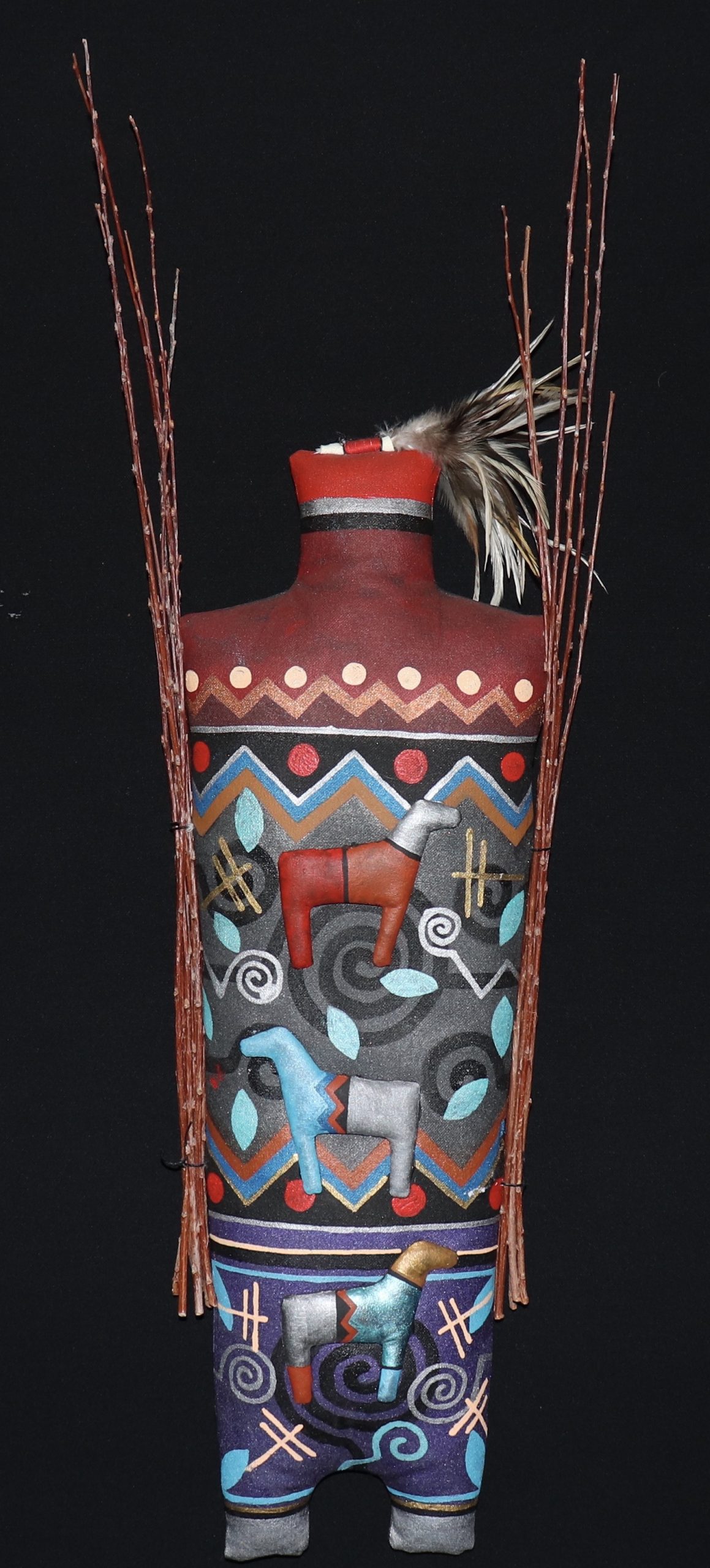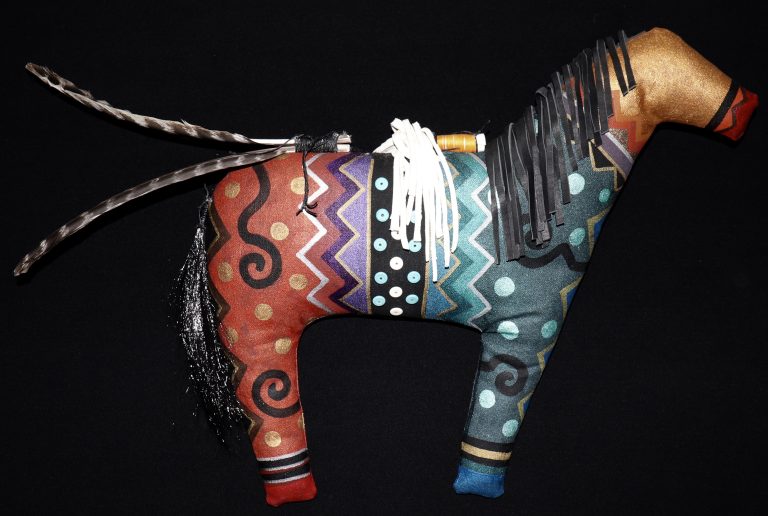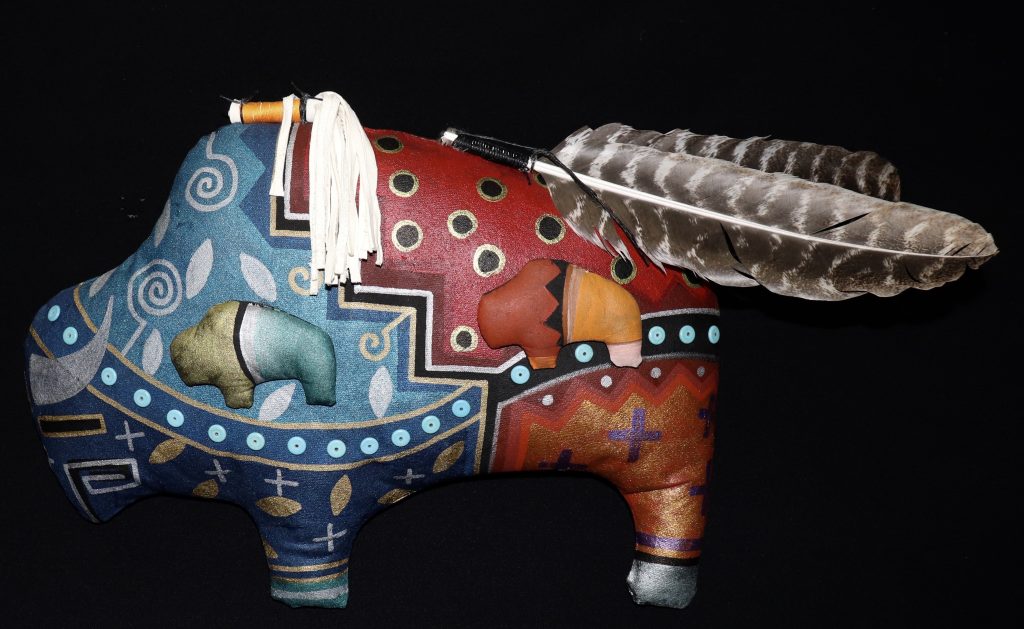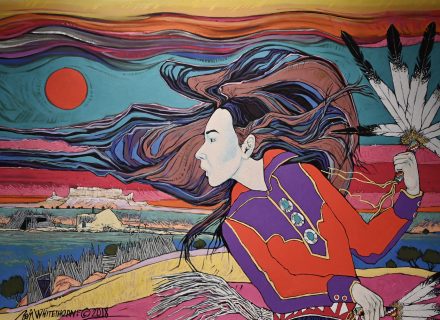Navajo artist Peter Ray James uses his gift to fulfill his mother's declaration that he was to be a storyteller, and the stories he tells more than earn him the name of “One Who Delivers the Message.”
What’s in a name? A lot in the case of Navajo artist Peter Ray James. His father, Fred James, came from a family of counselors; Fred’s father’s name was “One Who Carries the Message.” Peter’s mother, Rena James, came from a military family; her father was a Navajo code talker during World War II. When her son was born, Rena declared that he wasn’t a warrior but was instead a storyteller. She gave him the name Nā’hat’āh Yīĺth Wōod, “One Who Delivers the Message.”
And that’s precisely what James does, using paintings, masks, and fabric “spiritual” sculptures as his mediums.
“My ideas spawn from a spiritual well that originated my life, my family, my clan, and my religion. There is only one way to express my life, and that is through Navajo traditional thought and process,” reads James’ artist statement on the website of the Wheelwright Museum of the American Indian, which sells his work in its museum shop. His work is also featured in the collections of celebrities like Ted Danson, Jon Bon Jovi, Phylicia Rashad, and Wynonna Judd and in galleries across the Southwest.
 Pueblo Snow Storm, 20" in diameter by Peter Ray James.
Pueblo Snow Storm, 20" in diameter by Peter Ray James.
Raised near Gallup, New Mexico, James spoke Navajo at home and went to public high school just outside the Navajo reservation on the outskirts of Grants.
“No Indigenous culture or customs were taught at school,” he says. “My community was highly cultural but not highly immersed in Navajo religious traditions and ceremonies, and the men did not have long hair.”
After high school he thought he would follow in his grandfather’s footsteps and enroll in the military, but one of his teachers saw talent in the teenager and suggested he enroll in the Institute of American Indian Arts in Santa Fe.
“Even though my passion was art, I had never studied art,” James says.
It wasn’t until he got to the institute and was surrounded by Indian culture that he found his path.
“I felt like I was living in a Hollywood movie. Most of the students there had long hair and wore beads and feathers. These were real Indians, and I was not raised like that,” he says.
The experience inspired him to start imitating Native artists: “If an art student painted a tepee, I would paint one alongside them.”
After graduating from the institute with honors in 1984, he attended the University of New Mexico in Albuquerque.
“I finally found my style there by visiting Anasazi pottery sites and studying anthropology and Southwest art,” he says. “I met so many Native art students who would take me to their homes, from Arizona to New York, and I would attend ceremonies with them.”
A visit to New York would send him down a new path.
 Tree of Life by Peter Ray James
Tree of Life by Peter Ray James
“I went to visit some good Iroquois friends in New Town, New York, and attended their midwinter ceremony,” James recalls. “There I met Peter Jones, a renowned Iroquois artist. He showed me how he made his masks by rolling out the clay. He stressed that I should bless others through my work and be authentic to my heart and soul.”
Returning to New Mexico, James started buying clay and making masks.
“I call my masks storyteller masks. They look like paintings that tell a story in the composition of a mask,” James says. “When I roll out the clay, I look at it like a flat earth. Then I bundle up newspaper under the clay to give it shape and start building from sea level to the mountains. The work becomes a three-dimensional painting, and I add such adornments as feathers, representing how birds soar.”
James also got into creating spirit sculptures out of leftover fabric from stretching his own canvases for his paintings.
 A Mother's Love Tree of Life, 18" L x 18" W by Peter Ray James.
A Mother's Love Tree of Life, 18" L x 18" W by Peter Ray James.
“I first started with the scraps I found in the basement; I didn’t want them to go to waste,” he says. “At that time, my wife was making some Navajo dolls, so I decided to do a freehand sculpture of a large figurine, based on rock art from the Freemont culture. My first 15 figures were all different sizes and one-of-a-kind, 2 or 3 feet high.” He sews and stuffs the sculptures, paints designs on the fabric, and hand signs each one.
Fifteen years later, he’s buying 15 yards or more of canvas at a time to use for his paintings and soft sculptures.
“I am a human being with so much information about my culture that one art medium is not enough to translate my messages,” James says. “All I know is that our Creator blesses me in a very talented way.”
For James, making art is not about making money. “I just want to enrich people’s lives,” he says. And he wants to deliver a message of Navajo blessing: “In beauty may you enrich your life and your family. Keep alive your family tradition and make it spiritual. Give to all people you can—with that comes fruitfulness.”
 Human by Peter Ray James
Human by Peter Ray James
An exhibition of the work of Peter Ray James is on view through January 29 at Toh-Atin Gallery in Durango, Colorado, with an artist reception on December 16 (toh-atin.com). James is represented by Jackson Clark II ([email protected]).
Check out more influential artists and get your own copy of our January 2023 issue now.





















